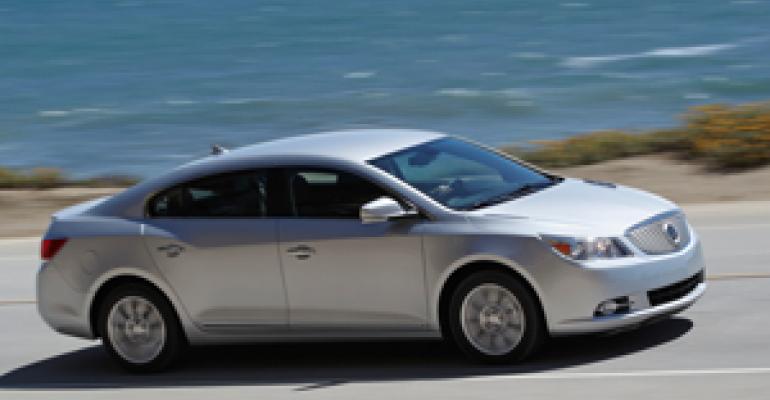
PALO ALTO, CA – General Motors, which as part of its turnaround wants to be known as a maker of fuel-efficient passenger cars, will not refer to the e-Assist system on the ’12 Buick LaCrosse as a hybrid.
“We’re calling it eAssist because it is a more descriptive term of what the system is,” says Daryl Wilson, lead development engineer for eAssist at GM.

“Although it is a hybrid by definition, it does not fit many of the preconceived notions people have about a hybrid,” he tells Ward’s during testing of the system here.
Chief among those is a potentially mistaken assumption the vehicle will travel on battery-electric power exclusively at some point during operation.
The Toyota Prius and Ford Fusion hybrid, as well as GM’s own fullsize truck hybrids, use the battery from a stop and to as fast as 25 mph (40 km/h) to conserve fuel.
GM’s eAssist does not. Instead, eAssist provides an electrical “boost” to the system’s 2.4L 4-cyl. internal-combustion engine when accelerating heavily, climbing a grade or leaving a stop.
The electric power comes courtesy of a 115V air-cooled lithium-ion battery pack stashed in the floor behind the rear seats. A 15-kW (20 hp) electric motor-generator mounted directly to the engine replaces the alternator to provide boost to the engine and meets electrical demands when the engine is shut off.
The system provides up to 15 hp of additional power, drawing the analogy of “a stop/start system on steroids” for its 26% improvement in fuel economy over the standard 4-cyl. powertrain.
“People also obviously associate a hybrid with great fuel economy, but also with some compromises in the goal to achieve great fuel economy,” Wilson says.

“We’re selling a Buick LaCrosse, first and foremost, a great car with great efficiency, not the technology necessarily under the hood that gets you that great efficiency.”
GM thinks the approach also will help take the technology more mainstream.
Just 2.5% of all vehicles on U.S. roadways today use stop/start systems, but the systems are expected to proliferate as auto makers seek to boost the efficiency of their fleets ahead of tough new corporate average fuel economy peaking in 2016.
Lawmakers in Washington are currently planning even tougher rules for 2017 and beyond and a mark of 54 mpg (4.4 L/100 km) by 2025 is expected as early as Friday.
“That’s why it is the base condition of the LaCrosse, as well,” Wilson says.
The price of a base LaCrosse will increase because of eAssist, from $27,745 for ’11 to about $29,960 for ’12. The hike would bring 4-cyl. prices even with what GM charges for LaCrosse models equipped with the 3.6L V-6.
Many consumers pay a premium to drive a hybrid because it makes a statement about their values, as much as it saves them dollars at the pump. The fact is not lost on Wilson.
“Certainly that is part of the market,” he admits, saying GM marketers spent many hours debating whether to put even the tiniest piece of green badging on the car.
Early on, a number of items were developed, including wake-up screens for the navigation system and driver-information center that said “hybrid.”
“The other piece is, we didn’t want to over-promise and under-deliver,” he says. “It’s a large, luxurious vehicle. It’s not going to put 50 mpg (4.7 L/100 km) on window (sticker).”
Perhaps no auto maker knows the risk of the hybrid game better than GM. Hybrid options offered on the previous-generation Chevy Malibu and defunct Saturn Aura midsize sedans accounted for 8,511 deliveries in their 2-year lifespan, because cheaper models with a traditional 4-cyl. engine achieved comparable fuel economy.
And while the 2-Mode Hybrid trucks GM sells today get better fuel economy than their counterparts, the auto maker nonetheless drew criticism for putting the technology, as well as a swatch of hybrid decals, on a fullsize truck.
Meanwhile, GM’s biggest competitor Toyota has used the Prius hybrid to claim the title of greenest auto maker in most consumers’ eyes.
“We’ve gone entirely the other direction before,” Wilson says. “With this vehicle, it’s understated, and the only badging you see is LaCrosse.”
GM estimates fuel economy from the LaCrosse at 25-36 mpg city/highway (9.4-6.5 L/100 km). It represents a 20% increase in highway fuel economy and a 32% boost in the city cycle, compared with previous models.
Ward’s averaged 28 mpg (8.4 L/100 km) in mixed driving here, or slightly better than the 26.6 mpg (8.8 L/100 km) average yielded during testing of pre-production models earlier this year.
Engineers also smoothed out shift patterns from the 6-speed automatic transmission and made the transitions between traditional and electrically assisted driving modes almost imperceptible.
The LaCrosse also receives several exterior enhancements to help improve efficiency, such as active aero shutters behind the grille, more aluminum bits and pieces on the chassis instead of cast iron, low-rolling resistance tires and under-body panels to help air slip through better.
The system proves particularly good at taking on the rolling hills of Northern California, as eAssist intervenes here and there to easily pull the 3,835-lb. (1,671-kg) sedan up grades its previous 4-cyl. powertrain would have been taxed to climb.
One minor drawback: an air-conditioning system that shuts down at stops alongside the engine when operating the vehicle in its most efficient “Eco” mode. It makes for a warmer but not altogether uncomfortable cabin until the light goes green.
Look for GM to heat up the fuel-economy race further in the spring, when eAssist debuts on the Buick Regal and next-generation Malibu.




